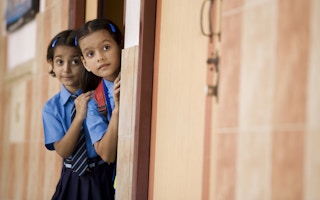Lilia Caberio is from Sulangan, in the Philippines. In 2013, her house was destroyed by the 170 mile per hour winds and 6-metre high storm surge during Typhoon Haiyan, and for a while she lived with her family in a tent erected where her home used to be. The typhoon was frightening enough for Lilia, but homelessness must have felt even more so. Until Elizabeth came along.
To continue reading, subscribe to Eco‑Business.
There's something for everyone. We offer a range of subscription plans.
- Access our stories and receive our Insights Weekly newsletter with the free EB Member plan.
- Unlock unlimited access to our content and archive with EB Circle.
- Publish your content with EB Premium.
Dr Elizabeth Hausler Strand is the founder and CEO of Build Change, an organization based in Colorado, USA, established to build disaster-resilient homes and buildings in emerging nations. Elizabeth also happens to be a qualified bricklayer.
She and her team worked with Lilia to build a new, resilient home that will last a lifetime. Elizabeth is, quite literally, building a sustainable future for families like Lilia’s in disaster-prone parts of the developing world, and in doing so she is empowering women all over the region to become the architects of their own lives.
Build Change is just one example of the many sustainable development solutions bubbling up from the ground which are designed by and for women. In a world faced with the social, economic, and environmental consequences of climate change, it is women and girls who risk losing the most. Lilia and her family were lucky to survive Typhoon Haiyan, but many didn’t – and many more won’t.
The statistics show that women and girls are more likely to die in natural disasters than men. What’s more, women around the world aged 15 to 44 are more at risk from rape and domestic violence than from cancer, car accidents, war and malaria. Globally, as many as 62 million girls are denied an education, and as working women they still only earn about 77 per cent of their male counterparts’ salary.
These are awful, unacceptable facts, and for too long they have resulted in women being depicted only as victims. In 2014 a UN Women report on gender equality and sustainable development drove this point home by saying, ‘Women should not be viewed as victims, but as central actors in moving towards sustainability.’ I couldn’t agree more.
It is our moral duty to address the disproportionate impact of our changing planet on women, but just as importantly, it is the smartest move we can make. Women’s knowledge and collective action is all too often overlooked in the quest to find sustainable solutions and business models – at our peril.
The global goals have firmly positioned gender equality and the empowerment of women within the context of sustainable development, and it has given us a new and critical timeline to keep up with. Goal number five states that we must achieve gender equality and empower all women and girls. But what’s resoundingly clear is that gender equality is both an individual goal in itself, and the means by which we can reach so many more.
For the past five years, Sustainia has been tracking the world’s best sustainable solutions, and the trend shows that more and more women are establishing viable, scalable, affordable solutions which disrupt business models, straddle sectors and needs, turn risks into opportunities, and contribute to economies. When we back women – and we back their solutions – we back the world.
“
It is our moral duty to address the disproportionate impact of our changing planet on women, but just as importantly, it is the smartest move we can make.
Here are just three of my favourite solutions that demonstrate how women are building our sustainable future:
Tonlé
Garment workers are some of the world’s most poorly paid and badly treated employees in the world – and the majority of them are women. Rachel Faller addresses this systemic issue in Cambodia through her clothing business, Tonlé, which hones in on transparency, fairness and waste-reduction as its founding principles. The result is a business which pays its (almost entirely female) workforce a living wage, creates a nurturing and healthy working environment, and – the cherry on the top – produces zero waste.
Noora Health
When four strangers were assigned a class project at Stanford Design School, they had little idea how far it would go. Edith Elliot is the CEO of Noora Health, a training and education platform in India that gives patients and their families high-impact health skills which create better outcomes and save lives. Women and girls spend substantially more time than men undertaking unpaid care work, particularly caring for children and sick relatives – this solution equips communities to manage this in a more efficient and effective way.
Triip.me
Ha Lam worked in the travel industry for over nine years, helping tourists explore her home city of Ho Chi Minh City in Vietnam, before she founded Triip.me. Described as the Airbnb for tour guiding, it’s a platform that enables private individuals to create tours of their own neighbourhood. Because of the low-to-no start-up costs for someone to become a guide, it’s a great way for women without formal qualifications to become independent entrepreneurs.
These are just a few of the most inspiring women in sustainability. Visit Sustainia’s 100 solutions initiative to find out more.
Katie McCrory is the global communications lead for Sustainia. This article was written exclusively for Eco-Business.











